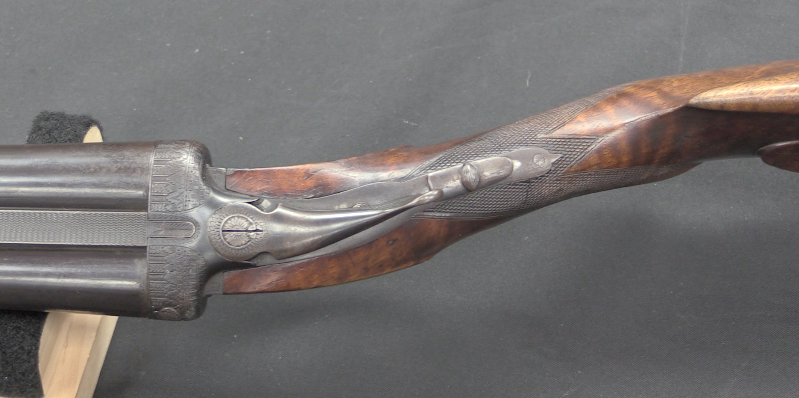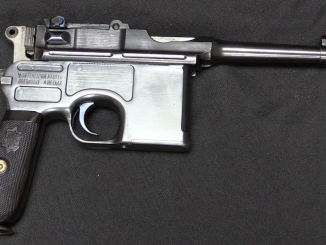With the end of World War One, it was finally possible for the French military to replace the 8mm Lebel cartridge with a modern rimless cartridge, and they wasted no time in doing so. By 1924 a new round had been adopted, and along with it a new modern light machine gun. Next, the arsenals would start working on converting 8mm rifle to the new cartridge. The first candidate was the Lebel, and in 1927 a conversion was approved and a batch of a few hundred made – but this was a more expensive and time consuming process than anyone wanted. After some brief trials, it was decided to work on adapting the Berthier instead, and in 1934 a conversion designed form St Etienne was approved as the 1907/15-M34.
This new design used a new 22.5″ barrel (570mm), a Mauser style internal 5-round double stack magazine, and new sights. The receivers and trigger parts were retained from the rifles being converted, along with the nosecaps and barrel bands, but not much else. Still, these conversions were put into production alongside the manufacture of new MAS-36 bolt action rifles. By the time of the German invasion about 63,000 M34 Berthiers had been converted, and were issued to frontline troops. They would fight in the Battle of France, and would also be used by German occupation forces as the Gewehr 241(f).





At least the French didn’t pretend that war would not come again. The problem was the competency of their high command… Italy was worse off, as shown at the bridge of Saint-Louis near Menton in 1940.
“You shall not pass!!” Do you need to know how many Frenchmen defended that bridge? Only nine, compared to 5000 attacking Italians. Granted, the French had lots more artillery… or am I wrong?
Bull’s eye!
In fact they were in a casemate and had artillery cover coming from the surrounding fortifications, and also some supply.
Despite their indisputable bravery, italian soldiers didn’t pass.
Ian;
Enjoyed the series on the Berthier, I picked up a few things I did’nt know about them. It appears that these were much better rifles than I thought they were, (see, I did learn something) always interesting to watch your vids, Thanks
It’s very interesting to see how firearms (and cartridges) development draws parallels between France, Italy, and to a lesser degree, the former states of the Austrian Empire (ie: Berthier 7.5 vs Carcano 7.35 vs Mannlicher M1895 8×56mmR).
Also how the Great Depression impacted on the timing of the introduction of these innovations.
Thanks Ian
“how firearms (and cartridges) development draws parallels between France, Italy, and to a lesser degree, the former states of the Austrian Empire (ie: Berthier 7.5 vs Carcano 7.35 vs Mannlicher M1895 8×56mmR)”
Yes and not. All mentioned become aware that they need new cartridge, but implemented different solution.
Italy increased bore diameter (IIRC for reuse of old worn-out 6,5 barrels)
France got brand new cartridge, with a bit smaller diameter of bullet
Hungary introduced 8×56 R with Spitzer bullet which allowed older 8×50 R to be reworked for it
Correct. Considering everything else they needed to spend money on, like completely new warplanes, etc., they decided that a cartridge of larger bore based on the existing 6.5 x 52mm case would allow them to simply bore out barrels and chambers to the new spec, instead of having to buy entirely new rifles (or at least new barrels)was the least worst alternative.
Granted, the war caught them in the middle of the changeover, and they ended up with nit one but two standard cartridges. the 6.5 x 52 and the 7.35 x 51. (Three, if you count the 8 x 59mm Breda.)
That still left them in better shape than the Japanese, who had no less than five. (6.5 x 50, 7.7 x 58, 7.7 x 58SR, 7.7 x 58R aka 0.303in British, and 7.9 x 57mm.)
Things must have been a bit complicated for their supply officers, to say the least.
cheers
eon
The Italians never issued 7.35mm weapons to front line units during the war. If they saw any combat service in Italy, it would have been only briefly in 1943. On the other hand, they did use some former Austro-Hungarian small arms in 8×50mmR Mannlicher.
As for the Japanese, .303 British was used only by the Navy, which had a separate supply system anyways.
“first candidate was the Lebel”
Why? How many Lebel and how many Berthier fit-to-service has France after end of war in 1918?
I find it interesting that the French did not choose a larger than 5 round magazine for their post-WW1 rifles. In fact the British Empire seems to have remained the only power with the significantly higher capacity magazine than 5 rounds in a bolt action rifle. I can only suppose that the extra “reserve” capacity was not considered worth the possible problems with a larger magazine.
I wonder if ISIS used any Berthier’s in 7.62 Russian. It doenst seem like converting them is a big task…
Awww, the M34. I have wanted to add one to my collection for years. Every time I have the money, the rifles are nowhere to be found. Everytime I don’t have the money, two or three come up for auction. One of these days…….
Is it the case that the Berthier ’07/15 was the least-expensive-to-produce WWI service rifle?
“A semi-auto conversion prototype for the Berthier…” Oh! Do tell!
France went to war in WWII with no fewer than 7 rifles in… 2 calibers? Yes?
The Berthier M16 was the most commonly issued of those seven, no?
Really looking forward to the book! You’ve got several chapters here, that is for sure. I’m wondering of the fat front sight of the 8x50R cartridge Berthiers made modification to the 7.5x54mm M1929 cartridge that much easier to accomplish?
Very informative. Any idea on when these were formally removed from French service at least? Also, the Indochinois model and carbine stacking swivel look positively Swiss!
It is a shame that the Berthier M34 only turned up so late in the day. There was really nothing stopping the French from having this rifle in 1914, except that they had made so many Lebels. Nonetheless, it looks like a very handy rifle, apart from the traditional French disdain for a safety catch. Did they ever wonder why every other country had one?
I would be very interested to see one of the 7.5 mm Lebels if possible.
Doctrine.
Always doctrine.
If your doctrine says “Outside battle, carry your weapon empty” (to avoid accidents), not having safety is coherent : there is no grey zone. Clear, simple, dumb can get the point, inattentive people can’t mess.
Then at our level, this can sound stupid and dangerous :
some guy were ordered to protect a truck with empty rifles but not authorized to open dedicated ammo crate in case of attack.
Same think happened during the 70’s for conscripts guarding some military base :
they received a handgun loaded with a plastic-covered magazine. To shoot, they had to unload, remove plastic then reinsert magazine. Then follow warning procedure about “not trespassing” etc… Then shoot the intruder if needed (or alive enough to do so).
Of course there could be times when the weapon is loaded but you want to make it safe. I think the French were indeed rather doctrinaire on this point. I wonder how their figures for accidental discharges compared to other armies?